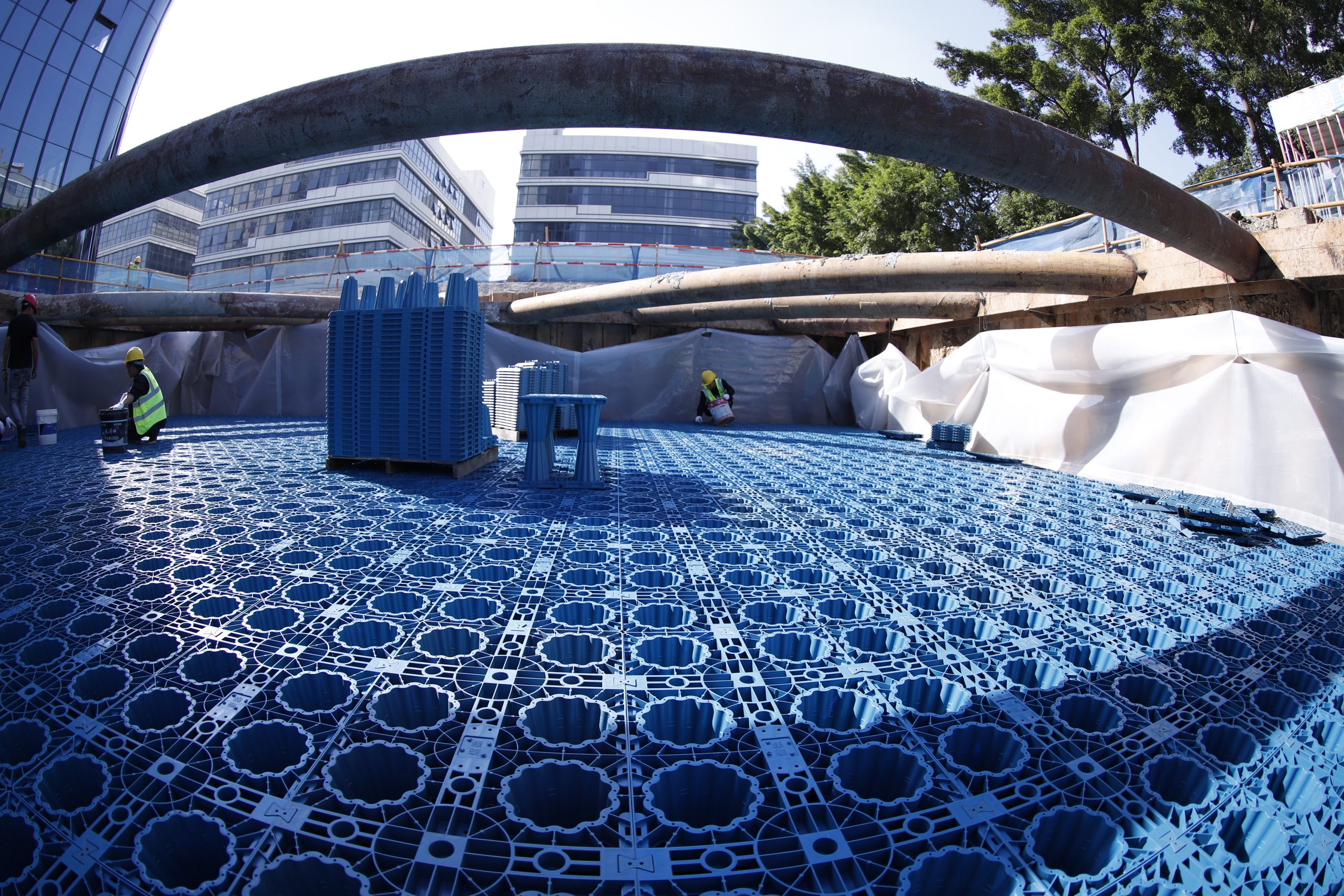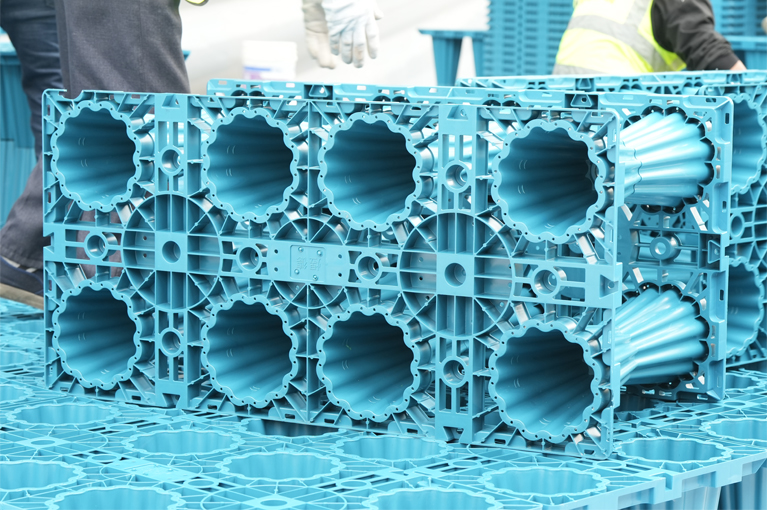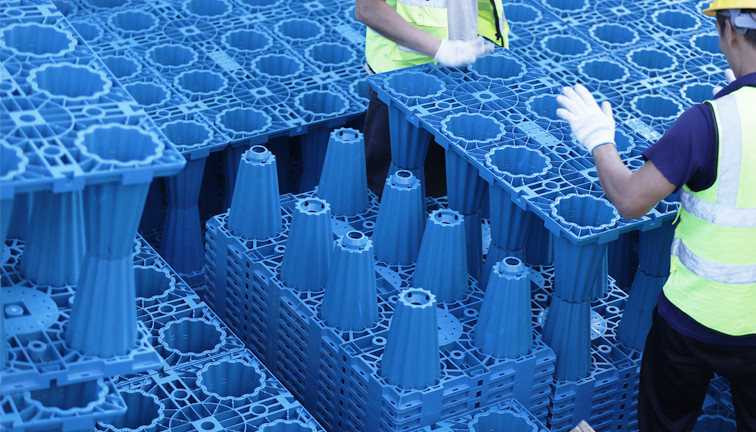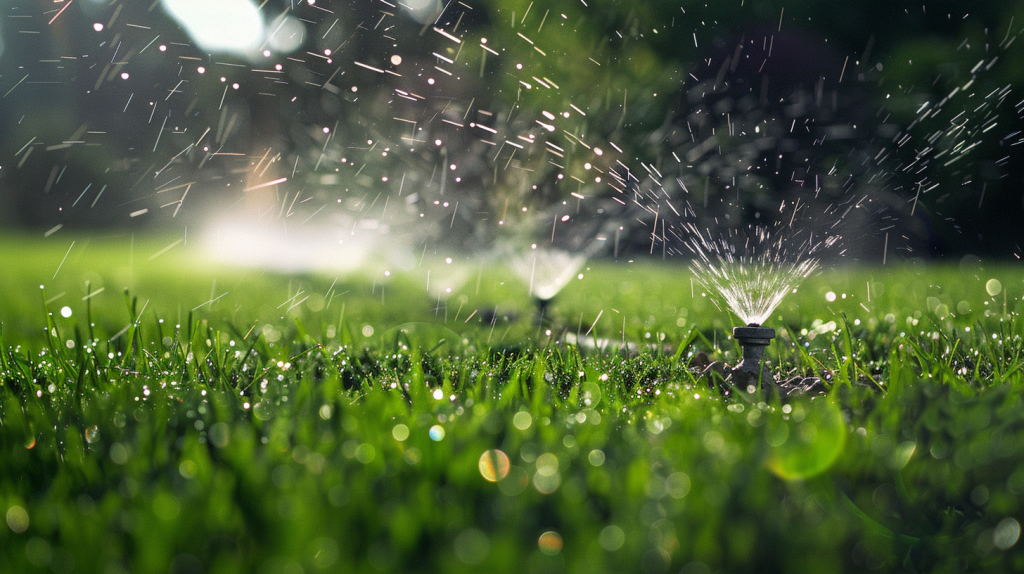Introduction:
In an era of increasing urbanization and climate change, effective rainwater management has become a critical concern for both urban planners and property owners. The proper handling of stormwater runoff is essential for preventing flooding, protecting water quality, and promoting sustainable water use. This comprehensive guide explores three key rainwater management systems: soakaway crates, detention tanks, and attenuation tanks. We’ll delve into their benefits, functionalities, and applications to help you make an informed decision for your specific needs.
Understanding Soakaway Crates: Benefits and Functionality
Soakaway crates, also known as infiltration crates or soakaway cells, are underground structures designed to manage surface water runoff by allowing it to percolate gradually into the surrounding soil. These modular units are typically made of high-strength plastic and are stackable, making them versatile for various installation depths and configurations.
Benefits of Soakaway Crates:
- a) Efficient land use: Soakaway crates can be installed underground, preserving valuable surface space for other purposes.
- b) Improved groundwater recharge: By allowing water to seep into the ground, soakaway crates help replenish natural aquifers.
- c) Reduced strain on drainage systems: By managing runoff at the source, soakaway crates alleviate pressure on municipal storm sewers.
- d) Sustainable solution: Soakaway crates mimic natural drainage processes, promoting eco-friendly water management.
- e) Versatility: These systems can be easily adapted to fit various site conditions and requirements.
Functionality of Soakaway Crates:
Soakaway crates work by collecting surface water runoff and storing it temporarily in their void spaces. The water then gradually percolates into the surrounding soil through the crate’s permeable sides and bottom. This process not only manages the quantity of runoff but also helps improve water quality by filtering out pollutants as the water passes through the soil.
Key components of a soakaway crate system include:
Inlet pipe: Directs water from surface runoff or downpipes into the crate system.
Geotextile membrane: Surrounds the crates to prevent soil infiltration while allowing water to pass through.
Inspection chambers: Enable maintenance and monitoring of the system’s performance.
Overflow mechanism: Provides a safe outlet for excess water during extreme events.
According to a study by the UK Environment Agency, properly designed soakaway systems can reduce peak runoff rates by up to 30% in urban areas, significantly mitigating flood risks.
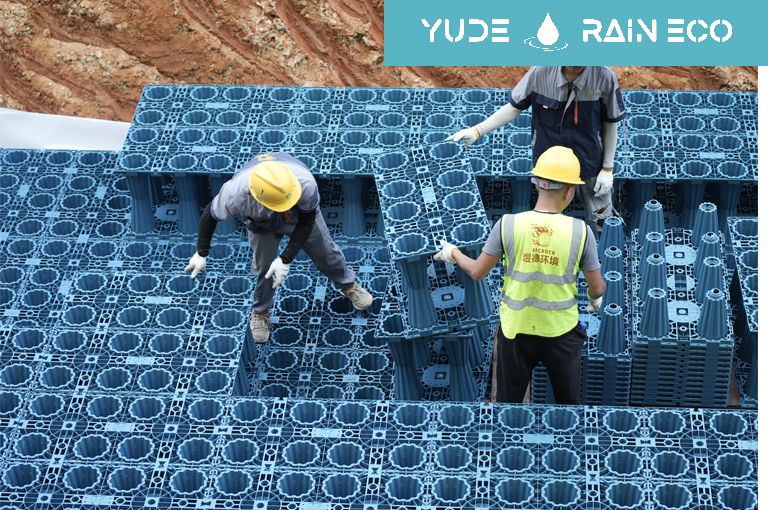
Detention Tanks: Effective Strategies for Managing Rainwater Flow
Detention tanks are large-scale storage facilities designed to temporarily hold stormwater runoff and release it at a controlled rate. These tanks play a crucial role in preventing downstream flooding and erosion by attenuating peak flows during heavy rainfall events.
Benefits of Detention Tanks:
- a) Flood prevention: By storing excess runoff, detention tanks reduce the risk of downstream flooding.
- b) Erosion control: Controlled release of water minimizes erosion in natural watercourses.
- c) Water quality improvement: Detention allows sediments and pollutants to settle, improving the quality of discharged water.
- d) Adaptability: Tanks can be designed to suit various site constraints and storage requirements.
- e) Potential for water reuse: Some detention tank systems can be adapted for rainwater harvesting purposes.
Functionality of Detention Tanks:
Detention tanks operate on a simple principle: they capture stormwater runoff during peak flow periods and release it slowly over an extended period. This process, known as flow attenuation, helps to match post-development discharge rates with pre-development conditions, thereby minimizing the impact on existing drainage infrastructure.
Key components of a detention tank system include:
Inlet structure: Directs runoff into the tank, often incorporating a debris screen.
Storage chamber: The main body of the tank where water is temporarily held.
Outlet control device: Regulates the rate at which water is released from the tank.
Overflow mechanism: Provides a safe discharge route for extreme events that exceed the tank’s capacity.
Access points: Allow for inspection and maintenance of the system.
Research published in the Journal of Hydrologic Engineering indicates that properly sized detention tanks can reduce peak discharge rates by 40-60% in urban developments, significantly mitigating the risk of downstream flooding and erosion.
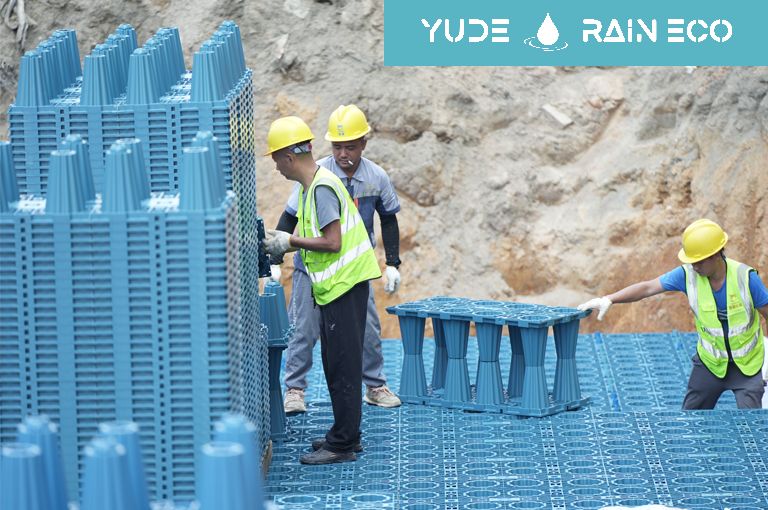
Design and Application of Attenuation Tanks
Attenuation tanks, also known as stormwater attenuation tanks, are engineered structures designed to store large volumes of rainwater runoff and release it at a controlled rate. These tanks are crucial in managing stormwater in areas where space is limited or where infiltration into the ground is not feasible.
Design Considerations for Attenuation Tanks:
- a) Storage volume: The tank size is determined based on the catchment area, rainfall intensity, and allowable discharge rate.
- b) Flow control: Outlet structures are designed to regulate the release of water, typically mimicking pre-development flow rates.
- c) Structural integrity: Tanks must be designed to withstand soil and hydrostatic pressures, as well as traffic loads if installed under trafficked areas.
- d) Maintenance access: Provision for regular inspection and cleaning is essential for long-term performance.
- e) Water quality treatment: Some attenuation tanks incorporate features for sediment removal and pollution control.
Applications of Attenuation Tanks:
Urban development: Attenuation tanks are widely used in new residential and commercial developments to manage increased runoff from impervious surfaces.
Highway drainage: These systems help manage road runoff, preventing flooding and pollution of nearby water bodies.
Industrial sites: Attenuation tanks can be designed to manage both stormwater and process water in industrial settings.
Retrofit solutions: They can be installed in existing developments to address drainage issues or comply with updated regulations.
Combined with other SuDS: Attenuation tanks can be part of a wider Sustainable Drainage System (SuDS) strategy, working in conjunction with other techniques like permeable paving or swales.
According to a report by the Construction Industry Research and Information Association (CIRIA), attenuation tanks can reduce peak flow rates by up to 75% when properly designed and implemented, making them highly effective in flood risk management.
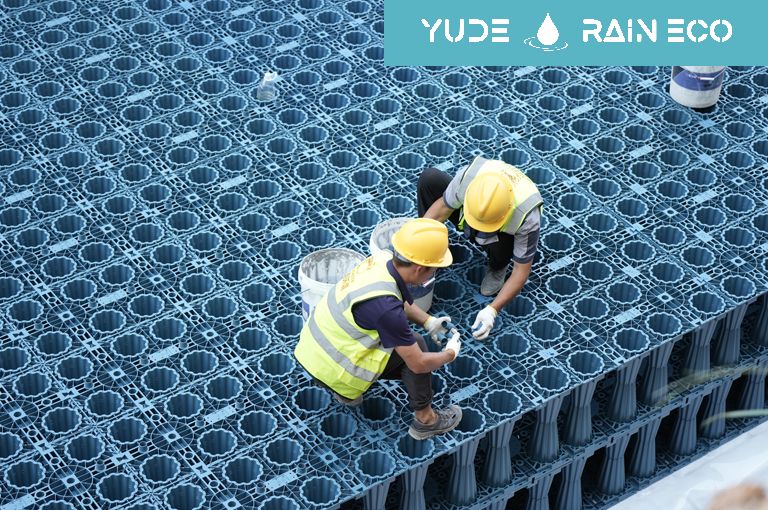
The difference between Detention Tanks, Attenuation Tanks, and Soakaway Crates
While detention tanks, attenuation tanks, and soakaway crates all serve the purpose of managing stormwater runoff, they have distinct characteristics and applications:
Detention Tanks:
Primary function: Temporarily store water and release it at a controlled rate
Water discharge: Released into existing drainage systems or watercourses
Storage duration: Short-term (usually hours to days)
Ground interaction: Limited to no infiltration into surrounding soil
Best suited for: Large-scale developments, areas with high runoff volumes
Attenuation Tanks:
Primary function: Store water and release it slowly to mimic natural flow patterns
Water discharge: Controlled release into drainage systems or natural watercourses
Storage duration: Medium-term (can be days to weeks)
Ground interaction: No infiltration, fully sealed systems
Best suited for: Urban areas with limited space, sites with poor soil infiltration
Soakaway Crates:
Primary function: Facilitate water infiltration into the surrounding soil
Water discharge: Primarily through infiltration into the ground
Storage duration: Short-term (hours to days)
Ground interaction: High level of interaction with surrounding soil
Best suited for: Areas with permeable soils, smaller-scale applications
Key Differences:
Discharge method: Detention and attenuation tanks release water into existing systems, while soakaway crates allow water to infiltrate into the ground.
Storage capacity: Detention and attenuation tanks typically have larger storage volumes compared to soakaway crates.
Soil requirements: Soakaway crates require suitable soil permeability, while tanks can be used in various soil conditions.
Water quality improvement: Soakaway crates offer natural filtration through soil, while tanks may require additional treatment features.
Space requirements: Tanks often require less surface area but more depth, while soakaway crates can be more spread out but shallower.
A study published in the Journal of Environmental Management found that the choice between these systems can result in a 15-30% difference in overall stormwater management efficiency, highlighting the importance of selecting the right solution for each specific site.
Comparison Table:
| Feature | Soakaway Crates | Detention Tanks | Attenuation Tanks |
| Primary Function | Infiltration | Temporary Storage | Flow Rate Control |
| Space Efficiency | High | Low | Medium |
| Groundwater Recharge | High | Low | Low |
| Water Quality Improvement | Low | Medium | Low-Medium |
| Peak Flow Reduction | Medium | High | Very High |
| Adaptability to Soil Conditions | Limited | High | High |
| Maintenance Requirements | Low | Medium | Medium-High |
| Initial Cost | Low-Medium | High | Medium-High |
| Suitability for Large Volumes | Medium | High | High |
| Potential for Water Reuse | Low | Medium | Medium-High |
This comparison highlights that each system has its strengths and weaknesses, and the best choice depends on the specific requirements of your project and site conditions.
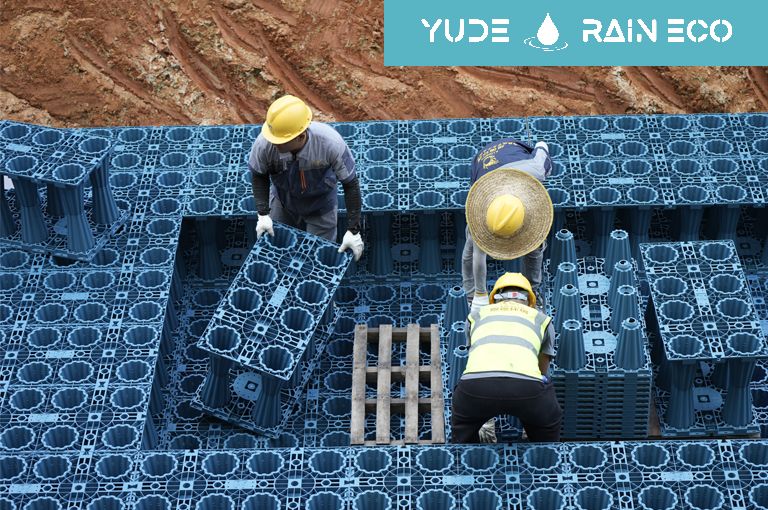
How to Choose the Right Rainwater Management System for Your Project?
Selecting the most appropriate rainwater management system requires careful consideration of various factors:
A. Site characteristics:
Soil permeability: Conduct percolation tests to determine if soakaway crates are suitable. Soils with infiltration rates below 1 x 10^-6 m/s may not be suitable for soakaways.
Groundwater level: High water tables can limit the effectiveness of soakaway systems and may require alternative solutions like detention or attenuation tanks.
Available space: Consider both surface area and depth constraints when choosing between systems.
Topography: Slope and natural drainage patterns can influence system selection and design.
B. Regulatory requirements:
Local regulations: Check with local authorities for specific requirements regarding stormwater management and permissible discharge rates.
Environmental considerations: Some areas may have restrictions on groundwater recharge or require specific water quality treatment measures.
C. Project scale:
Small-scale residential: Soakaway crates might be sufficient for individual properties.
Large-scale developments: Detention or attenuation tanks may be more suitable for managing larger volumes of runoff.
D. Runoff characteristics:
Volume: Calculate the expected runoff volume based on the catchment area and local rainfall data.
Peak flow rates: Determine the required attenuation to meet allowable discharge rates.
E. Long-term maintenance:
Consider the accessibility and maintenance requirements of each system.
Factor in the life-cycle costs, including regular inspections and potential repairs.
F. Water quality objectives:
If water quality improvement is a priority, consider systems that offer natural filtration (like soakaways) or incorporate treatment features.
G. Potential for water reuse:
If rainwater harvesting is desired, some detention or attenuation tank systems can be adapted for this purpose.
H. Climate change resilience:
Factor in predicted changes in rainfall patterns and intensity when sizing and selecting systems.
Decision-making process:
Conduct a thorough site investigation, including soil tests and topographical surveys.
Calculate runoff volumes and required storage capacity using local rainfall data and climate change projections.
Consult with local authorities to understand specific requirements and restrictions.
Evaluate the pros and cons of each system in the context of your specific project needs.
Consider a combination of systems if a single solution cannot meet all requirements.
Conduct a cost-benefit analysis, including both initial installation and long-term maintenance costs.
Consult with stormwater management professionals – Yude Rain Eco for expert advice and design assistance.
According to a survey by the American Society of Civil Engineers, projects that involve a comprehensive site analysis and consider multiple stormwater management options are 40% more likely to meet or exceed performance expectations over their lifespan.
Comparative Analysis: Pros and Cons of the Three Rainwater Management Systems
Soakaway Crates:
Pros:
Promotes natural groundwater recharge
Requires minimal maintenance when properly designed
Can improve water quality through soil filtration
Versatile and adaptable to various site layouts
Cost-effective for smaller scale applications
Cons:
Effectiveness depends on soil permeability
Not suitable for areas with high groundwater tables
May require significant surface area in poor soil conditions
Potential for clogging over time, reducing efficiency
Limited capacity compared to tank systems
Detention Tanks:
Pros:
Can handle large volumes of runoff
Effective in reducing peak flow rates
Suitable for various soil conditions
Can be designed for water quality improvement
Potential for integration with rainwater harvesting systems
Cons:
Higher initial cost compared to soakaway crates
Requires regular maintenance to ensure proper function
May need pumping systems in certain configurations
Limited contribution to groundwater recharge
Larger footprint may be required for significant storage volumes
Attenuation Tanks:
Pros:
Highly effective in managing peak flow rates
Can be installed in areas with limited surface space
Suitable for sites with poor soil infiltration
Offers precise control over discharge rates
Can incorporate water quality treatment features
Cons:
Generally the most expensive option
Requires regular maintenance and inspection
No contribution to groundwater recharge
May require complex control systems
Potential for structural issues if not properly designed and installed
A study published in the Journal of Water Resources Planning and Management found that the choice of stormwater management system can impact project costs by 15-25%, with long-term maintenance costs varying by up to 40% between different systems.
Best Practices and Considerations for Implementing Rainwater Management Solutions
Regardless of the system you choose, there are several best practices and considerations to keep in mind when implementing rainwater management solutions:
- Integrated Approach: Consider implementing a train of SuDS (Sustainable Drainage Systems) techniques rather than relying on a single solution. This could involve combining source control measures (like green roofs or permeable paving) with site control (such as soakaways or attenuation tanks) and regional control measures (like retention ponds).
- Regular Maintenance: Develop and adhere to a comprehensive maintenance schedule to ensure the long-term effectiveness of your chosen system. This should include regular inspections, cleaning, and replacement of components as needed.
- Water Quality Treatment: Incorporate pre-treatment measures to improve water quality before it enters the main system. This could include catch basins, sediment forebays, or bioretention areas to remove pollutants and debris.
- Climate Resilience: Design systems with future climate projections in mind. This may involve providing additional capacity or incorporating adaptive features that can be adjusted as rainfall patterns change.
- Multi-functional Design: Where possible, design rainwater management systems to serve multiple purposes. For example, detention basins can double as recreational areas during dry periods, or attenuation tanks can be integrated with rainwater harvesting systems for non-potable use.
- Monitoring and Performance Evaluation: Implement monitoring systems to track the performance of your rainwater management solution over time. This data can be used to optimize system operation and inform future designs.
- Stakeholder Engagement: Involve relevant stakeholders, including local authorities, environmental agencies, and community members, in the planning and design process to ensure broad support and compliance with local requirements.
- Life Cycle Cost Analysis: Consider not just the initial installation costs but also long-term operational and maintenance expenses when comparing different solutions.
- Environmental Impact: Evaluate the environmental impact of different systems, including their carbon footprint, use of materials, and potential effects on local ecosystems.
- Scalability and Flexibility: Design systems that can be easily expanded or modified to accommodate future development or changing requirements.
- Education and Awareness: Provide educational materials and signage to inform the public about the importance and function of rainwater management systems, particularly for visible features like detention basins.
- Integration with Existing Infrastructure: Carefully consider how new rainwater management systems will interact with existing drainage infrastructure to ensure compatibility and avoid unintended consequences.
- Emergency Planning: Develop contingency plans for extreme events that may exceed the design capacity of the system, including clear protocols for monitoring, notification, and response.
- Use of Technology: Explore the use of smart technologies, such as real-time monitoring and control systems, to optimize the performance of rainwater management solutions, especially for large-scale or complex installations.
- Biodiversity Enhancement: Look for opportunities to enhance local biodiversity through the design of rainwater management systems, such as incorporating native plants in detention basins or creating habitats around attenuation ponds.
Case Studies and Best Practice Examples:
-
Portland, Oregon’s Green Streets Program:
- Portland has implemented an extensive network of bioswales, rain gardens, and permeable pavements in conjunction with underground storage systems. This integrated approach has reduced stormwater runoff by up to 80% in some areas while enhancing urban aesthetics.
-
Copenhagen’s Cloudburst Management Plan:
- Following severe flooding in 2011, Copenhagen developed a comprehensive stormwater management plan combining blue-green infrastructure with traditional engineering solutions. The plan includes the use of detention road systems, which transform streets into temporary water storage during extreme rainfall events.
-
Singapore’s Active, Beautiful, Clean Waters Program:
- This initiative integrates stormwater management with urban design, creating multi-functional spaces that manage runoff while providing recreational amenities. The program includes a mix of naturalized waterways, bioretention systems, and underground storage tanks.
-
Melbourne’s Water Sensitive Urban Design:
- Melbourne has adopted a city-wide approach to stormwater management, incorporating a range of techniques including rainwater harvesting, bioretention systems, and underground storage. This integrated approach has significantly reduced potable water demand and improved the health of local waterways.
Industry Statistics and Trends:
According to the Environmental Protection Agency (EPA), properly designed and maintained stormwater management systems can reduce annual runoff volume by 50-80% in urban areas.
A report by Grand View Research predicts the global stormwater management market to grow at a CAGR of 9.3% from 2021 to 2028, driven by increasing urbanization and stricter environmental regulations.
The International Water Association reports that cities implementing integrated stormwater management strategies have seen a 30-50% reduction in flood-related damages over a 10-year period.
A study published in the Journal of Environmental Management found that combining green infrastructure with traditional engineered solutions can improve overall system performance by 20-35% compared to single
Emerging Trends and Future Outlook
As the global focus on sustainable urban development and climate resilience intensifies, the field of rainwater management is witnessing several emerging trends and innovations that are shaping the future landscape:
Integrated Blue-Green Infrastructure:
There is a growing emphasis on combining traditional “grey” engineering solutions with nature-based “green” infrastructure, such as wetlands, bioswales, and rain gardens. This integrated approach aims to mimic natural hydrological processes, enhance urban ecosystems, and provide multiple benefits beyond just stormwater management.
Smart Stormwater Systems:
The integration of sensor technology, data analytics, and automated control systems is enabling the development of “smart” stormwater management systems. These systems can monitor real-time conditions, optimize storage and release, and adapt to changing weather patterns, improving overall efficiency and resilience.
Decentralized Stormwater Management:
Instead of relying solely on centralized, large-scale infrastructure, there is a shift towards decentralized, distributed stormwater management solutions. This includes the widespread adoption of small-scale, localized systems like permeable pavements, green roofs, and rainwater harvesting at the building or neighborhood level.
Water Reuse and Circular Economy:
With growing water scarcity and the need for sustainable resource management, rainwater harvesting and the reuse of stormwater are gaining traction. Captured and treated stormwater can be repurposed for non-potable applications, such as landscape irrigation, toilet flushing, or industrial processes, contributing to a more circular water economy.
Nature-Based Solutions:
Drawing inspiration from natural ecosystems, there is an increased focus on nature-based solutions for stormwater management. These include the restoration of wetlands, the creation of natural detention basins, and the integration of vegetation to enhance infiltration, evapotranspiration, and water quality improvement.
Climate Change Adaptation:
As the impacts of climate change become more pronounced, rainwater management strategies are evolving to address the challenges posed by more frequent and intense rainfall events, rising sea levels, and changing precipitation patterns. Resilient design, scenario planning, and the incorporation of climate change projections into system sizing and performance modeling are becoming crucial.
Holistic Asset Management:
Stormwater infrastructure is increasingly being viewed as a vital asset that requires comprehensive planning, maintenance, and life-cycle management. Asset management approaches, including condition assessments, predictive maintenance, and long-term investment strategies, are being adopted to ensure the longevity and performance of rainwater management systems.
Regulatory Drivers and Incentives:
Stricter environmental regulations, such as requirements for on-site stormwater retention, water quality standards, and flood risk mitigation, are pushing the adoption of innovative rainwater management solutions. Additionally, incentive programs, green infrastructure subsidies, and market-based approaches are encouraging the implementation of sustainable stormwater practices.
Case Studies and Successful Implementation Strategies
Case Study 1: Singapore’s Bishan-Ang Mo Kio Park
Overview: Transformation of a concrete drainage canal into a naturalized, meandering stream within a public park.
Key Strategies:
Incorporation of bioswales, detention ponds, and native vegetation to manage stormwater.
Multifunctional design providing flood mitigation, water quality improvement, and recreational amenities.
Collaboration between government agencies, landscape architects, and the community.
Results: Reduced flood risk, enhanced biodiversity, and increased public engagement with the natural environment.
Case Study 2: Seattle’s Street Edge Alternatives (SEA) Streets
Overview: Implementation of a decentralized, neighborhood-scale stormwater management approach.
Key Strategies:
Installation of swales, rain gardens, and permeable pavement along residential streets.
Community engagement to address concerns and gather feedback during the design process.
Monitoring and adaptive management to optimize system performance.
Results: Reduced runoff volumes, improved water quality, and enhanced neighborhood livability.
Case Study 3: Philadelphia’s Green City, Clean Waters Program
Overview: Comprehensive, city-wide stormwater management initiative focused on green infrastructure.
Key Strategies:
Deployment of various green infrastructure elements, including rain gardens, green roofs, and pervious surfaces.
Prioritization of projects in areas with high flood risk and environmental justice concerns.
Leveraging public-private partnerships and incentives to encourage private property owners’ participation.
Results: Significant reduction in combined sewer overflows, improved aquatic ecosystem health, and job creation in the green infrastructure sector.
Key Lessons Learned:
Stakeholder Engagement: Involve the community, local authorities, and relevant stakeholders throughout the planning and implementation process to foster buy-in and address concerns.
Multifunctional Design: Strive for holistic, integrated solutions that provide additional benefits beyond just stormwater management, such as improved public spaces, habitat creation, and educational opportunities.
Adaptive Management: Monitor system performance, gather feedback, and be prepared to make adjustments to optimize the effectiveness of rainwater management strategies over time.
Incentives and Partnerships: Leverage financial incentives, regulatory frameworks, and collaborative partnerships to encourage private sector participation and expand the reach of sustainable stormwater practices.
Capacity Building and Knowledge Sharing: Invest in training programs, knowledge exchange platforms, and technical assistance to support the successful implementation and long-term maintenance of rainwater management systems.
These case studies demonstrate the importance of a comprehensive, collaborative, and adaptive approach to rainwater management, ultimately leading to more resilient and sustainable urban environments.
Conclusion and Key Takeaways
The effective management of rainwater is a crucial component of sustainable urban development and climate resilience. As we have explored, there are various rainwater management systems, each with its own advantages and considerations, including soakaway crates, detention tanks, and attenuation tanks.
The decision-making process for selecting the most appropriate system should consider factors such as site conditions, regulatory requirements, project scale, runoff characteristics, long-term maintenance, water quality objectives, and potential for water reuse. A comparative analysis of the pros and cons of each system can help guide the decision-making process.
To ensure the success and longevity of rainwater management solutions, it is essential to follow best practices, such as comprehensive site assessment, integrated design, proper sizing and modeling, quality control during installation, regular maintenance and monitoring, and regulatory compliance.
Emerging trends in the field of rainwater management, such as the integration of blue-green infrastructure, the adoption of smart technologies, the shift towards decentralized solutions, and the focus on water reuse and circular economy, are shaping the future of sustainable urban water management.


